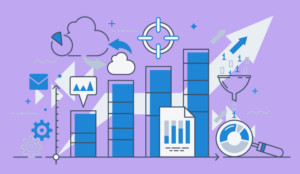CallMiner define what is meant by the term “data mining”, before sharing techniques, tools and tips for doing so.
Data mining is the process of collecting, assimilating and utilizing information for anomalies and/or benefits. The data is typically collected from large databases and processed to determine patterns and other correlations.
These patterns can be statistical; an example is that the unemployment rate can be derived and predicted using data mining. Correlations can also be used in the realm of machine learning.
For instance, businesses sometimes use data mining to construct machine learning programs to predict customer behavior.
4 Benefits of Data Mining
The uses of data mining are vast. While it’s not an extensive list, here are some broad business-centered benefits of data mining:
1. Planning, forecasting and decision-making
Taking a look at vast amounts of information about past transactions, competitor intel, and other details can help a business plan for upcoming seasons and even forecast revenue targets.
2. Reducing security and other risk factors
Data mining can uncover common risks at various points of an organization. Taking a look at things like how software is being used and how well policies are followed can yield an accurate calculation of risk.
3. Finding new customers
Data mining can also show potential revenue streams, inspire ideas for new products, and reveal different market opportunities for reaching prospective customers.
4. Better caring for current customers
Using data to gather information about how an organization (and competitors) care for their customers can dramatically improve retention and satisfaction.
Data Mining Techniques
There are two main types of data mining: predictive and descriptive. There are a couple of main techniques for each of these mining operations.
Predictive Data Mining Techniques
Predictive data analysis, as its name suggests, aims to forecast outcomes based on a set of circumstances. The most common predictive data mining techniques include regression and classification:
Regression
Typically dealing with numeric values, regression data mining allows things like pricing and value to be calculated. An example of regression would be predicting voter trends.
Classification
Similar to regression, classification attempts to yield a predicted outcome, yet without a numeric value.
For instance, Credit Karma uses information based around credit scores and credit company standards to highlight the probability of an individual being approved for a credit card.
The classifications are things like “poor,” “fair,” “good,” and “excellent.”
Descriptive Data Mining Techniques
Descriptive data analysis relies on historical data to understand trends and evaluate changes over time. The most common descriptive data mining techniques include association rule and clustering:
Association Rule
Much like it sounds, this type of data mining is looking for associations (things like patterns and correlations) based on massive amounts of information seen within databases.
One funny, often-cited example of association rule mining is known as the diaper and beer correlation.
Clustering
Again, much like it sounds, clustering is a mining process of gathering and grouping bits of information based on certain characteristics.
An example of this would be email marketing software that allows users to segment their audience.
Data Mining Tools
Data mining tools run the gamut from simple to complex, open source tools to comprehensive enterprise-grade platforms capable of complex analysis.
To capture the most relevant data needed to drive informed decision-making, many companies turn to sophisticated data mining and analysis tools.
A SaaS-based engagement and speech analytics platform, CallMiner Eureka offers multi-channel text and speech analytics, enabling you to capture data from every customer interaction, regardless of channel – that means phone, email, chat, social media, surveys, and more.
A robust platform like CallMiner Eureka enables the capture of both structured and unstructured data, allowing for the capture and integration of customer dialog, customer sentiment, and agent performance with other data gleaned from sources such as chats and email for data mining and analysis.
Powered by the Eureka data mining engine, its comprehensive, AI-driven platform offers a complete range of customer intelligence solutions from real-time to post-contact analysis to meet the demands of modern enterprises.
3 Tips from Data Mining Experts
To get the highest-quality data and make the most of it, follow these expert data mining best practices.
1. Make Sure the Results of Your Data Mining Work in the “Real World“
“If you don’t deploy your model into the frontline and use it to affect your business’s performance in some way then you have spent a lot of time and expertise on an interesting research project that’s had no practical impact whatsoever.
Make sure that you have clear deployment routes in mind right from the start. You need to ensure that Marketing can use your cross-sell model, that Contact Centre staff can see your churn risk scores, that your acquisition modelling is being applied to new prospect campaigns.
If you don’t ensure your models are deployed then you’ll never be able to demonstrate the power of your work.” – Rachel Clinton, 9 tips for effective data mining, Data Science Central; Twitter: @DataScienceCtrl
2. Use a Holdout Sample
“A holdout sample is used as a reference sample to judge whether the model you are working upon has the ability to predict future scores.
This is based upon a sample of observations withheld from estimation to yield a predictive model. Preparing a holdout sample ensures that a model just for point-of-sale is not built which is based upon a defined set of data only.
Hence, it provides a robust way of building up a model.” – 6 tips on successful Data Mining, New Gen Apps
3. Make Sure Your Data Is Clean Before Starting
“It’s always a mistake to skip over the data preparation step in the CRISP-DM model. Even well-tended data warehouses are likely to have fields with missing data, duplicate records or other errors.
And these days, many data miners are accessing raw and unstructured data from data lakes or other repositories. Cleaning the data and getting it into a usable state is an absolute must.
In this step, it’s also vitally important to think through what the data is saying and apply common sense rather than just accepting the data as is.
For example, if your data includes records for pregnant men or people who are listed as parents but have zero children, you need to go back and figure out where things went wrong.” – Cynthia Harvey, Big Data Mining: 9 User Tips, Datamation; Twitter: @Datamation
What are your most important data mining techniques and best practices?
This blog post has been re-published by kind permission of CallMiner – View the Original Article
For more information about CallMiner - visit the CallMiner Website
Author: CallMiner
Published On: 3rd Oct 2019 - Last modified: 26th Feb 2025
Read more about - Expert Insights, Analytics, CallMiner






 CallMiner is the leading cloud-based customer interaction analytics solution for extracting business intelligence and improving agent performance across all contact channels.
CallMiner is the leading cloud-based customer interaction analytics solution for extracting business intelligence and improving agent performance across all contact channels. 
































